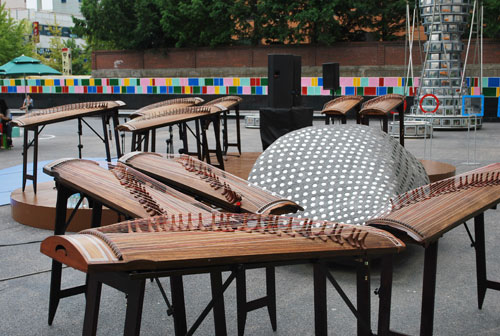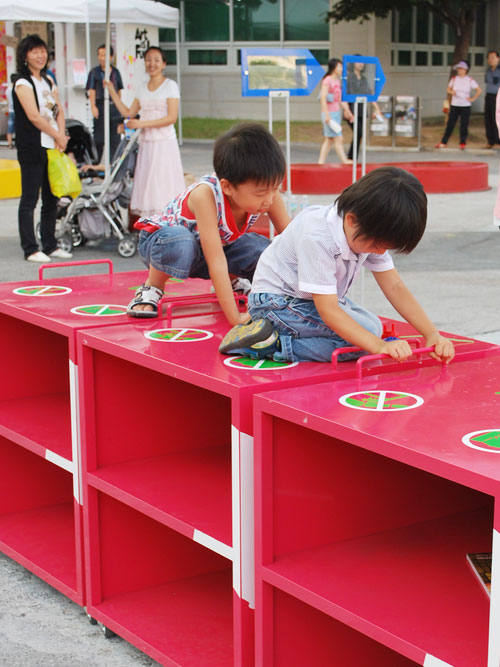
A huge sign greets passersby on the backside of one of the Gwangju Biennale’s exhibition halls.
The city of Gwangju in Korea’s South Jeolla Province is a bustling city of 1.4 million people. The city is perhaps best known as the site of a student democracy uprising in 1980, when 325 people were killed during protests against the military government of Chun Doo-hwan (전두환). As a result, many regard Gwangju as the heart of Korea’s democracy movement. But a generation later, while some don’t want to dwell on that tragic past, others continue to draw inspiration from it.
Case in point is the Gwangju Biennale, the nine-week contemporary art festival that’s recognized as one of the world’s leading large-scale global art exhibitions. Started in 1995, the Gwangju Biennale was Asia’s first biannual contemporary art festival. Organizers say that Gwangju’s tragic past inspires their work today, and ultimately, they hope to express their city’s spirit in art.

The gayageum (가야금) is a classical instrument indigenous to Korea.
On a warm autumn day outside the Biennale’s main exhibition hall, I felt that spirit. Seven students were performing the 12-string gayageum (가야금), a classical instrument that is indigenous to Korea, while children crawled on colorful, puzzle-shaped benches. I was excited to see what else the Biennale had to offer, and in front of me was the Main Exhibition Hall – five large galleries featuring hundreds of art pieces from around the world.

“Four Musicians (moo, roar, chee-ow, yeeeoh)” by South African artist Joachim Schoenfeldt. That’s a strong bird.
Upon entering the galleries, the first thing you hear is a repeating bell, and the first thing you see is a striking sculpture by South African artist Joachim Schoenfeldt. Picture this: A taxidermied cow stands on the back of a lioness, who rests atop an eagle, with a small peafowl hen bearing the weight of them all. This inverted pyramid of African animals set a surprising tone.

Children playing with outdoor installations in the courtyard of the main exhibition hall. I found the Biennale to be very family-friendly.
Unlike past Biennales, number seven has no theme. The title is simply, “Annual Report: A Year in Exhibitions.” The collections include dozens of traveling exhibits from the past year and an exploration of historical questions from a regional perspective.

Sorry, I misplaced my information on this installation.
In another gallery, “Sediments, Sentiments (Figures of Speech)”, a sculpture by the American artist Jennifer Allora and Cuban artist Guillermo Calzadilla, was a reminder of Gwangju’s turbulent past. A huge foam and white plaster form was bypassed by tunnels. A small speaker inside a tunnel played speeches of current and former world leaders like the Dalai Lama and Saddam Hussein in an operatic style. According to the artists, the sculpture resembles the aftermath of a disaster, and the singing represents the final soliloquy delivered in a tragic opera.

The Gwangju Museum of Art featured a fun exhibition of Taiwanese artists called “Sensory Topology: Bodily Perception of Taiwan Contemporary Art.”.
But with such a diverse collection, what brings it all together? The Biennale’s Nigerian-born Artistic Director Okui Enwezor says that this year’s festival continues its tradition of “rigorous globalism” but also aims to pay specific attention to how Gwangju and Korea’s postcolonial histories build an active civic identity. Sounds good, but I wanted to hear what some of the visitors had to say, so I returned outside. (Note: The audio version of this episode included audio clips of interviews with attendees from Azerbaijan, Canada and the U.S.)

Affectionate pigs at the Daein Traditional Market… with their overseer asleep in the back.
A free shuttle bus takes visitors on the 14-kilometer loop to four other festival sites. At the Daein Market (대인시장), a traditional public market in downtown Gwangju, there were graffiti installations by Korean artist Gu Hun-ju (구헌주). In one, Beijing Olympic gold medalist and world’s strongest woman, Jang Mi-ran (장미란) lifts the metal shutter of a market stall.

Site-specific graffiti installations like this one by Gu Hun-ju in the Daein Traditional Market were fun to happen upon.
In another, while walking in an alley I found myself amidst a game of laser tag by children painted in black and white. While it’s easy to criticize a lot of contemporary art as cliché, I enjoyed how the art was integrated into the living, breathing market.
The next festival location I visited was the Gwangju Theater (광주국장), located just a few blocks from the market. It’s is the city’s oldest and one of Korea’s last single screen theaters. For the Biennale, it’s screening Rainer Werner Fassbinder’s 15-hour television adaptation of an Alfred Döblin novel. The film follows Berlin in the early days of the Nazi movement and documents the inhumanity of Weimar Germany.

The Uijae Museum of Korean Art is a modern structure that commemorates a master of Korean traditional art. For the Biennale, it also featured works by over a dozen additional contemporary artists.
After two days of consuming contemporary art, my last stop was Mount Mudeung (무등산). Beside a babbling brook was the Uijae Museum (의재미술관), a small gallery dedicated to Huh Uijae (허의재), a scholar and master of Korean traditional art. Alongside master Huh’s paintings were photographs, paintings and small exhibits by nine contemporary artists.
I think the crowd favorite was Mariana Bunimov’s sculpture “Chocolate Shack.” I watched three women happily breaking off chucks of the chocolate house’s 100 kilos of edible walls… but the museum’s staff didn’t seem to mind.

Another installation from the “Sensory Topology” exhibit by Taiwanese artists. Notice the mirror’s “reflection.” Actually, you could walk inside the “mirror” into another exhibit.
So, there you have it, a quick peek at what the 2008 Gwangju Biennale had to offer. Although we could only take a small peek at what’s being offered, I hope doing so will persuade you to come see it for yourself. But if you’re planning to visit, you’d better hurry. The exhibits close their doors on November 9th, and won’t reopen until the 8th Biennale kicks off, in 2010.
You can learn more on the festival website.
Just one more thing- if you liked this special longer edition of Discovering Korea, please let us know!
Getting There:
→ From Seoul, take the KTX (bullet train) from Yongsan Station to Gwangju. Trip duration is approx. 3 hours and the cost is 38,000 won each way. Or, buses leave every five minutes from the Seoul Express Bus Terminal. The 4-hour ride costs between 15,100-22,400 won each way.Once in Gwangju, the Biennale is spread over five venues. A free bus circles the tour sites every 30 minutes, but taxis are cheap and plentiful. Admission: Adults pay 12,000 won; youths and children are 5,000 and 2,500 won, respectively. Multiple-day and family discounts available. 09:00-18:00. Exhibits open until November 9.
(A version of this text was aired as part of a special extended version of “Discovering Korea with Matt Kelley” on KBS World Radio on October 11, 2008.)



I’ve just read all your past posts, and they were all great, so informative, and great pictures. I can’t wait to see what’s next!
I’m a Korean living in Georgia, USA and have not been in Korea since I was 11. For years I’ve neither felt Korean nor American. Both my parents are Korean. When I was 4, I was sent to live with my aunt and her American husband in Gunsan. And shortly there after, we moved to the United States. I’ve recently started reading blogs of foreigners in Korea & Koreans in Korea and have felt somewhat reconnected…
PS: I found your website through Abby Off Air.
Thanks
By: Kim on 4 November 2008
at 23:48
Thanks a lot, Kim. It’s funny how many people share similar feelings to the ones you described. Maybe it’s even more common among those of us of Korean descent, whether we’re first-generation gyopo, mixed-race or adoptees… The Korean diaspora is certainly interesting! I hope you’ll visit Korea again soon.
On another note, I hope to travel to Seonyu Island off Gunsan sometime soon. I hear it’s quite beautiful and you can rent bikes to ride around the island.
Take care,
Matt
By: Matt Kelley on 10 November 2008
at 13:47